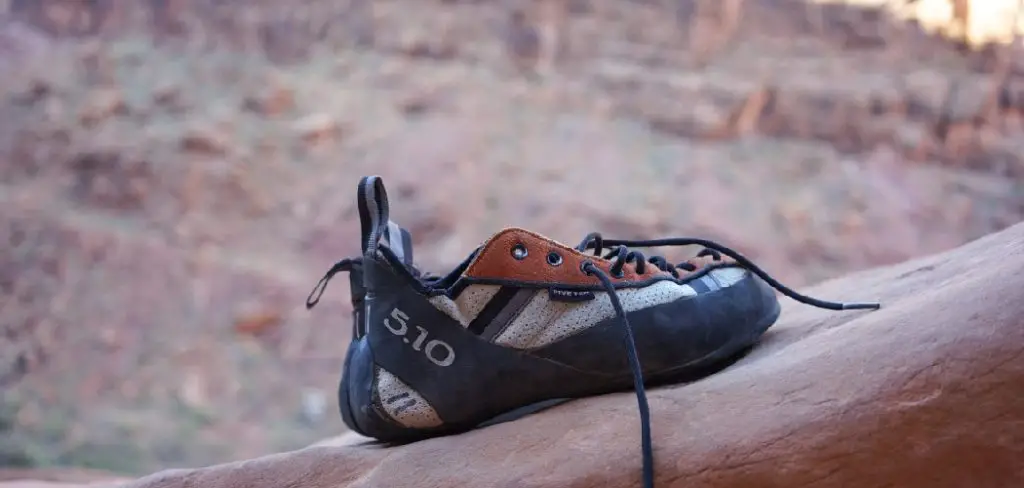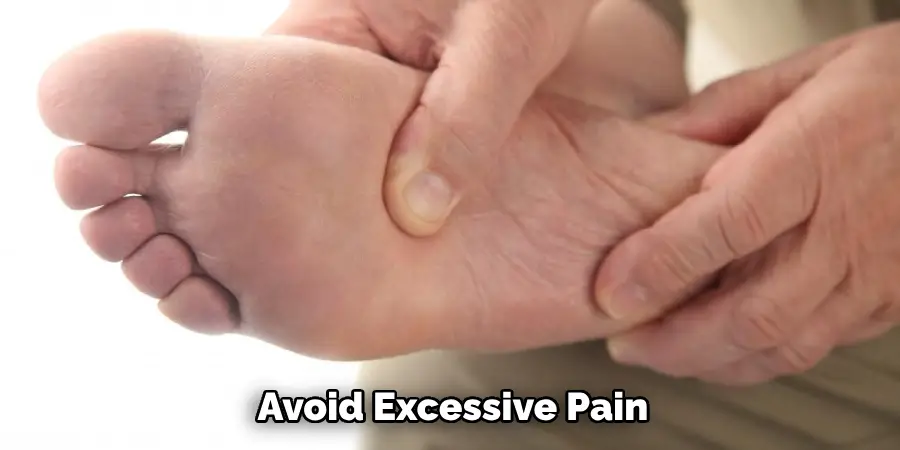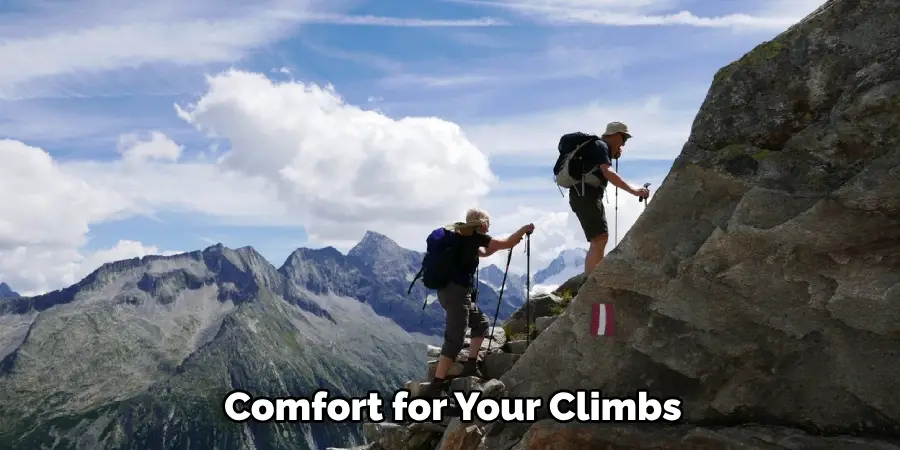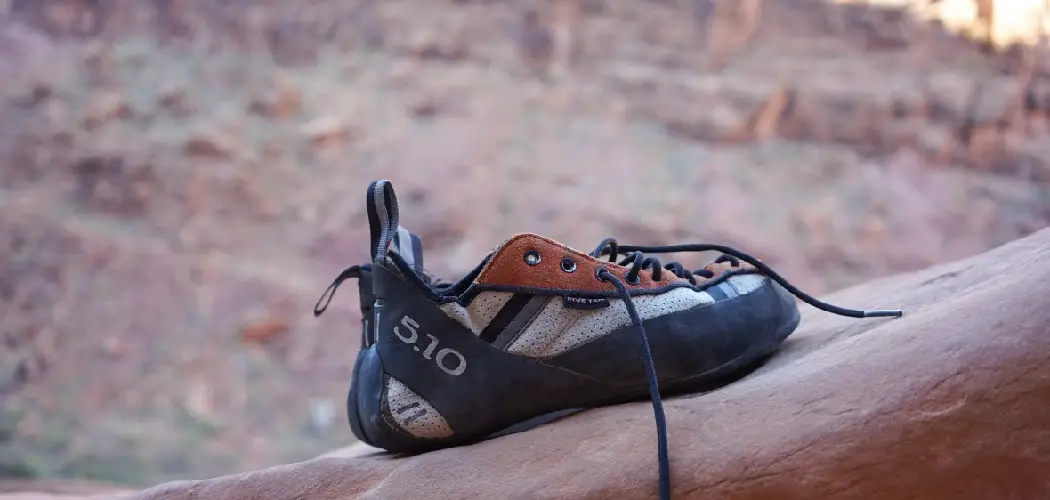Are you looking to size new climbing shoes? Choosing the right fit is crucial for performance and comfort. Here are some tips on how to size climbing shoes.
Choosing the right size climbing shoes is crucial for comfort and wall performance. Climbing shoes are designed to fit snugly to enhance sensitivity and support precise footwork. However, finding the perfect size can be challenging due to variations in brands, models, and personal preferences. Striking a balance between a tight fit and comfort is essential to avoid pain and ensure you can climb effectively.

This introduction will guide you through the fundamental considerations and steps to take when sizing climbing shoes, helping you select a functional pair suited to your climbing style.
What Will You Need?
To properly size your climbing shoes, you will need the following items:
- A pair of climbing shoes
- Socks (or no socks, depending on personal preference)
- Your usual climbing gear (chalk bag, harness, etc.)
It is important to note that it is best to try climbing shoes in person before purchasing them. This lets you get a feel for the fit and make any necessary adjustments.
10 Easy Steps on How to Size Climbing Shoes
Step 1: Determine Your Climbing Shoe Size
Start by measuring your foot to determine your general shoe size, which serves as a starting point for trying on climbing shoes. You can do this at home with a ruler or at a specialty climbing store where staff can assist you. Start with your known street shoe size, but remember that climbers often need a tighter fit for optimal performance. Climbing shoe sizes can vary significantly between brands and even between different models within the same brand, so being open to trying a range of sizes is crucial.
Be prepared to size down from your usual shoe size, as climbing shoes are meant to hug your foot tightly but still comfortable enough to avoid excessive pain. This initial measurement will help guide you in selecting the correct sizes to try on as you move forward.

Step 2: Try Shoes On in the Afternoon
When considering the best time to try on climbing shoes, aim for the afternoon or later in the day. Your feet tend to swell over the day, and trying shoes on during this period can give you a more accurate fit that will accommodate these natural fluctuations. This consideration is critical if you plan long climbing sessions, as a snug morning fit may become uncomfortably tight by afternoon.
By selecting shoes later in the day, you’re optimizing the likelihood that your chosen pair will remain comfortable throughout your climbing activities.
Step 3: Wear Climbing Socks (or Not)
Decide whether you prefer socks with your climbing shoes, as this can influence the fit. Some climbers wear thin socks for added comfort and to help manage moisture, while others prefer the direct feel and sensitivity of climbing without socks. Trying on the shoes with your usual choice—either with or without socks—will give you the most accurate sense of how the shoes will fit during actual use.
It’s important to replicate your typical climbing conditions to ensure the best possible sizing outcome as you try different models and sizes.
Step 4: Focus on the Toes
Ensuring a proper fit for your toes is crucial when sizing climbing shoes, as this directly affects your ability to perform precise footwork on the wall. When trying on climbing shoes, pay particular attention to how your toes feel inside the toe box. Your toes should be slightly curled but not painfully crammed or overlapping, as this can lead to discomfort during climbing.
The goal is to strike a balance where your toes are engaged to provide power and precision without causing cramps or pressure points that could detract from your climbing experience. This snug fit in the toe area aids in leveraging maximum force when edging and smearing on the rock face. Take the time to walk around or stand on small ledges in-store to assess whether the toe box offers the necessary support and comfort for your climbs.

Step 5: Check Heel Fit
The fit of the heel is another critical aspect to consider when sizing climbing shoes. A well-fitting heel should feel secure and snug, reducing the chance of unwanted movement within the shoe during climbs. Slippage in the heel can compromise your ability to heel hook or maintain a stable stance on the wall. When trying on shoes, ensure your heel stays firmly in place when you stand or simulate climbing movements like heel hooks.
The shoe should contour closely to your heel without digging in or creating hot spots. Experiment with different brands, as the cut and shape of the heel can vary significantly, impacting your comfort and performance.
Step 6: Assess the Arch Support
Arch support in climbing shoes is vital in providing stability and comfort during climbs. While climbing shoes are generally designed to fit tightly, it’s crucial to ensure that the arch aligns well with the natural curve of your foot. An adequately supported arch can improve power transmission from your leg to your toes, enhancing your ability to push off holds effectively.
When trying on shoes, notice how the arch feels—there should be no significant gap between the shoe and your foot, as this can lead to discomfort or inefficient power transfer. If you have pronounced arches or flat feet, consider trying different brands or models catering to these needs. The proper arch support can make a substantial difference in your climbing performance, providing the needed support for prolonged climbing sessions.
Step 7: Evaluate the Closure System
Selecting the appropriate closure system for your climbing shoes is essential for achieving a secure and customized fit. Climbing shoes feature various types of closures, including lace-ups, velcro straps, and slip-ons, each offering unique advantages. Lace-ups provide the most precise fit by allowing you to adjust the tightness along the entire shoe length, making them ideal for long routes.
Velcro straps offer convenience and quick adjustments, perfect for bouldering or when frequent shoe removal is needed. Slip-ons, often favored for indoor climbing or training, provide a snug fit with minimal fuss. As you try on different shoes, consider how each type of closure feels in terms of security and ease of use, ensuring that your choice can handle the demands of your climbing style while also offering comfort and support.

Step 8: Break in Your Shoes
Once you’ve selected the right climbing shoes, it’s essential to break them in gradually before embarking on intense climbing sessions. Initially, wear them around the house or during manageable climbs to allow your feet to adjust to the snug fit without causing discomfort. Each time you wear the shoes, you’ll notice they mold slightly to the shape of your foot, offering improved comfort and performance.
Pay attention to any persistent pressure points or areas of discomfort during this phase, as they may need further adjustments or indicate that a different size or model may suit your needs better. A well-broken-in pair of climbing shoes will enhance your climbing experience, providing the necessary balance between comfort and performance.
Step 9: Maintain Your Climbing Shoes
Proper maintenance of your climbing shoes is essential to prolong their lifespan and maintain performance. After each climbing session, clean the shoes by wiping them down with a damp cloth to remove dirt and chalk that can degrade the material over time. Allow them to air out thoroughly to prevent odors and bacteria build-up, which can occur from sweat and moisture inside the shoe.
Avoid exposing climbing shoes to excessive heat or direct sunlight, as this can damage the rubber and synthetic materials. If the soles begin to wear out but the rest of the shoe remains in good condition, consider resolving them to extend their usability.
Step 10: Store Your Climbing Shoes Properly
Proper storage of your climbing shoes can significantly affect their longevity and performance. After ensuring your shoes are clean and dry, store them in a cool, dry place away from direct sunlight and extreme temperatures. This helps prevent the degradation of the shoe materials and the rubber soles. Avoid cramming them into a tight space or leaving them in a climbing bag for extended periods, as this can cause deformations. Consider using a shoe bag or box to protect them during travel or storage.

By following these steps and finding the right fit, you can ensure your climbing shoes provide the best support and performance for all your climbing adventures.
Conclusion
How to size climbing shoes effectively is a crucial step for climbers of all levels. A well-fitting shoe enhances performance by improving power transfer and providing the necessary support for technical maneuvers.
Start by understanding your foot type and the demands of your climbing style, then proceed through each step thoughtfully—from selecting the toe box and heel fit to choosing the appropriate closure system. Remember, comfort is essential; a properly sized shoe should be snug but not painfully tight. Take your time breaking in new shoes and maintaining them well to ensure longevity.
By prioritizing these considerations, you set yourself up for a rewarding and successful climbing experience across all terrains.

